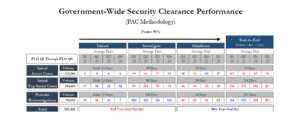Lawmakers push intelligence community to speed up hiring timelines
Congress wants intelligence agencies to work toward hiring most employees within six months.
Best listening experience is on Chrome, Firefox or Safari. Subscribe to Federal Drive’s daily audio interviews on Apple Podcasts or PodcastOne.
It’s no secret that it takes a long time to get hired by an intelligence agency.
But Congress is now looking for details from agencies on exactly how long it takes to bring in new employees, as well as a plan for improving those timelines.
The compromise fiscal 2023 National Defense Authorization Act released this week would require the director of national intelligence to send lawmakers a report on the time it takes onboard personnel in the intelligence community.
And for elements of the intelligence community where the median timeline is greater than 180 days, the bill would require those organizations to come up with a plan for improving the timeliness of the onboarding process.
Specifically, the NDAA would direct intelligence agencies to take actions to reduce the median timeline for onboarding new employees to less than 180 days by the end of 2023.
A major factor in the onboarding process is the time it takes to grant a new employee a security clearance. And while the background investigation backlog is drastically reduced from where it was just a few years ago, the latest numbers published on Performance.gov show it can still take weeks and months to get through the process.
In the fourth quarter of fiscal 2022, it took an average of 76 days to initiate, investigate and adjudicate a secret-level clearance for the fastest 90% of cases. For top-secret clearances, the end-to-end process took an average of 127 days for the fastest 90%.

Trusted Workforce 2.0 reforms
Agencies are aiming to speed up the clearance process under the “Trusted Workforce 2.0” initiative, and the legislative branch wants to know how it could potentially help with those reforms.
The NDAA would require White House leaders to submit a report on any legislative action required to implement Trusted Workforce 2.0.
And it would also require White House and intelligence community leaders to start delivering an annual progress report on personnel vetting processes starting next September. The report should include an “analysis of the timeliness, costs, and other related information for the initiations, investigations (including initial investigations and any required periodic reinvestigations), and adjudications for personnel vetting purposes,” the bill states.
Earlier this year, Deputy Director for Management Jason Miller called 2022 “the most significant year” for Trusted Workforce 2.0 . The initiative aims to “better support agencies’ missions by reducing the time required to bring new hires onboard, enabling mobility of the federal workforce, and improving insight into workforce behaviors,” according to the update posted on Performance.gov.
So far, the majority of the cleared population in government has been enrolled in “continuous vetting,” which involves a system that constantly monitors different sources of data for potential issues with a security clearance holder, such as an arrest or a suspicious financial transaction.
Continuous vetting has largely replaced the need to conduct periodic re-investigations of a clearance holder every five or 10 years, freeing up investigators to focus their efforts on new employees.
But Miller also said the “long pole in the tent” for Trusted Workforce 2.0 is the successful development of a new IT system called the National Background Investigation Services. NBIS aims to replace seven disparate, legacy IT systems with modern software for initiating and processing background investigations, hosting continuous vetting capabilities, and sharing data across agencies.
NBIS rolled out a new background investigation application earlier this year, a major step forward for the project. But hurdles remain for the NBIS program to meet a goal of shutting down and replacing the remaining legacy IT systems by this fiscal year.
Polygraph timeliness
Yet another factor for how long it takes to hire individuals into some intelligence positions is the time it takes to conduct a polygraph examination. An industry report estimates it can take anywhere from 30 days to 18 months to get through the polygraph process.
The NDAA would require the inspector general of the intelligence community to assess whether the current administration of polygraphs is meeting annual hiring requirements. The report should identify how many polygraphers the intelligence community needs to meet the demand. It should also review whether their might be alternatives to the polygraph, such as those being researched by the National Center for Credibility Assessment.
Additionally, the NDAA would have the director of national intelligence issue standard timelines for how long the polygraph process should take.
Copyright © 2024 Federal News Network. All rights reserved. This website is not intended for users located within the European Economic Area.
Follow @jdoubledayWFED



